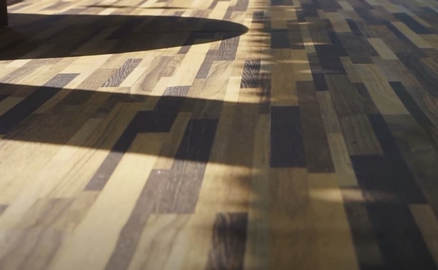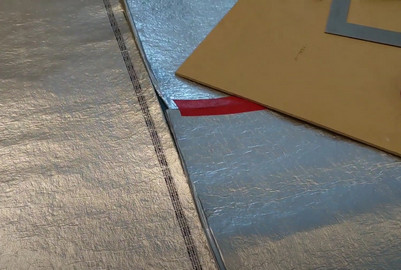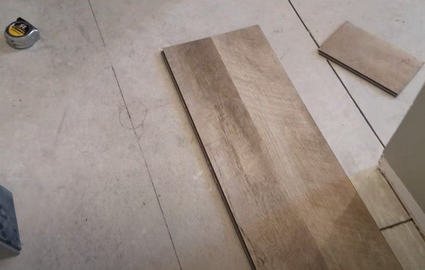Mastering The Art Of Laminate Flooring: A Comprehensive Guide
Are you considering using laminate flooring in your home but feel overwhelmed with the installation process, maintenance, and potential health effects? Look no further than this comprehensive guide to mastering the art of laminate flooring.

As homeowners ourselves, we understand the importance of affordability, durability, and style when it comes to choosing the perfect flooring for your home.
In this guide, we’ll explore the benefits and drawbacks of laminate flooring, where it’s best used, and even how to use it on walls. We’ll help you choose the right type of laminate flooring for your home and provide a step-by-step installation process.
Plus, we’ll share tips on how to maintain your laminate flooring and address any potential health concerns. By the end of this guide, you’ll have all the knowledge and confidence you need to successfully install and maintain beautiful laminate flooring in your home.
What is Laminate Flooring?
You may have heard of this affordable and durable option for your home – laminate floors. It’s a multilayer synthetic flooring product that simulates the look of more expensive options, such as hardwood floors.
The layers of laminate flooring include a wear layer, design layer, core layer, and underlayment. One of the advantages of laminate flooring is its affordability. It’s typically less expensive than hardwood floors, and it’s easy to install.
Additionally, laminate flooring is durable and scratch-resistant, making it a great option for homes with pets or children. When you’re considering flooring options for your home, keep in mind that laminate floors are typically sold by the square foot, so you’ll need to measure your space to determine how much flooring you’ll need.
Benefits of Laminate Flooring
Get ready to transform your floors with laminate – it’s like having a durable and stylish new layer that’s resistant to stains and wear and tear!
Laminate flooring is a popular choice among homeowners because it offers the look of hardwood floors at a fraction of the cost. Advantages of laminate flooring include its affordability, durability, and ease of installation.
Laminate floors are made up of layers of durable materials, including a high-density fiberboard core and a clear protective layer. The top layer of laminate flooring is designed to mimic the look of hardwood floors, tile, or even stone, making it a versatile option for any home.
Laminate flooring typically costs less per square foot than hardwood floors, making it a great option for those on a budget. Additionally, laminate floors are highly durable and resistant to scratches, stains, and wear and tear, making them a practical choice for high-traffic areas in the home.
Most laminate flooring is also designed with a click-and-lock system, making it easy for homeowners to install themselves without the need for professional installation.
Drawbacks of Laminate Flooring
Unfortunately, laminate flooring does have some drawbacks to consider before making your final decision. One of the main concerns with laminate floors is their susceptibility to moisture and water damage. Unlike hardwood floors, laminate floors are made of composite wood materials that can swell or warp when exposed to water. Therefore, it’s essential to clean up spills immediately and avoid installing them in high-moisture areas such as bathrooms or basements.
Luckily, some manufacturers offer waterproof laminate flooring options that can withstand water damage, making them a better choice for areas prone to spills or high humidity. Another drawback of laminate flooring is their hardness and noise when walked upon. Due to their composite wood core, laminate floors can be harder underfoot, which can lead to discomfort when standing for long periods.
Additionally, laminate flooring can be noisy when walked upon, especially with high heels or shoes with hard soles. However, these issues can be mitigated by using underlayment pads or rugs to absorb sound and provide cushioning. Overall, the quality of the product and professional installation can also affect the durability and noise level of the laminate floors, so it’s crucial to choose a reputable manufacturer and installer.
Where to Use Laminate Flooring
Laminate flooring is a versatile option that can be used in many areas of the home, from the cozy living room to the sleek kitchen. It is a practical and cost-effective alternative to hardwood floors, with a wide range of styles and textures available.
However, it is important to consider the best areas in the home to install laminate flooring, as well as any potential drawbacks. For high-moisture areas such as the bathroom, waterproof laminate flooring is a great option. It’s designed to withstand exposure to water and moisture, making it a durable and practical choice for these spaces.
Laminate flooring can also be used in commercial applications, such as offices and retail spaces, due to its ability to withstand high-traffic areas. However, it’s important to note that laminate flooring may not be the best choice for areas with heavy foot traffic, as it can be prone to scratches and dents over time.
Overall, laminate flooring is a versatile and affordable option for many areas of the home, as long as it’s installed and maintained properly.
Using Laminate Flooring on Walls
Did you know that laminate flooring can also be used on walls to add a unique and stylish touch to any room? This is a great alternative to traditional paint or wallpaper and can help create a modern and sophisticated look. Laminate floors are becoming increasingly popular for wall installation due to their durability, affordability, and ease of installation. In fact, using laminate flooring on walls can be a great way to achieve the look of hardwood floors without the added expense.
One of the main benefits of using laminate flooring on walls is that it is waterproof. This makes it a great option for rooms that are prone to moisture like bathrooms and kitchens. Additionally, laminate floors come in many different types and styles, allowing you to choose the perfect look for your space. When using laminate flooring on walls, it is important to consider the installation process and ensure that the walls are properly prepared. With the right tools and techniques, you can achieve a stunning and long-lasting look that will transform any room.
| Pros | Cons |
|---|---|
| Durable and long-lasting | Can be difficult to remove |
| Affordable alternative to hardwood floors | Limited color options |
| Waterproof | Can be prone to scratches |
| Wide variety of styles available | Not suitable for all wall surfaces |
Potential Health Effects and LEED Status
You may be wondering about the potential health effects of using laminate flooring in your home and how its LEED status can impact your decision-making process.
Laminate floors are made of composite wood materials that are pressed together and topped with a photographic layer that resembles wood. This layer is then coated with a clear protective layer that makes the floor durable and resistant to scratches, dents, and stains.
However, some laminate floors may contain formaldehyde, a common chemical used in adhesives and binders. Formaldehyde can cause eye, nose, and throat irritation, as well as headaches, asthma, and other respiratory problems. To minimize your exposure to formaldehyde, look for laminate flooring that meets the CARB (California Air Resources Board) standard for formaldehyde emissions.
If you are concerned about the health effects of laminate flooring, you may also want to consider its LEED status. LEED (Leadership in Energy and Environmental Design) is a green building rating system that evaluates the environmental performance of buildings and products.
If a laminate flooring product has LEED certification, it means that it has been verified to meet certain standards for energy efficiency, indoor air quality, and environmental sustainability. Some benefits of choosing LEED-certified laminate flooring include:
- Reduced exposure to harmful chemicals and toxins
- Improved indoor air quality
- Lower energy bills due to energy-efficient design
- Increased resale value of your home
While LEED certification is not required for residential or commercial applications, it can be a useful tool for consumers who want to make informed decisions about their flooring options. By choosing laminate flooring with LEED certification, you can feel confident that you are using a product that is safe, sustainable, and environmentally friendly.
Laminate vs. Other Flooring Options
If you’re trying to decide on the best flooring option for your home, it’s helpful to compare laminate with other popular choices like hardwood and luxury vinyl.
While solid hardwood flooring is considered the gold standard in flooring, it can be expensive and require regular maintenance. Laminate floors, on the other hand, offer a similar look at a fraction of the cost. Laminate flooring can be made to mimic the look of hardwood floors, while also being more durable and resistant to scratches and dents.
Additionally, waterproof laminate flooring options are now available, which make them a great choice for high-moisture areas like kitchens and bathrooms.
Luxury vinyl flooring is another popular choice, but there are some key differences between it and laminate floors. Luxury vinyl flooring tends to be more expensive than laminate, but also offers durability and water resistance.
However, laminate flooring often has a wider variety of styles and designs, including options that mimic the look of hardwood and stone. This versatility makes it easier to find a laminate option that will fit your design aesthetic and budget.
Overall, the advantages of laminate flooring make it a great choice for homeowners looking for a cost-effective and durable flooring option.
Choosing the Right Laminate Flooring
When it comes to choosing the perfect laminate flooring for your home, you want to picture yourself walking on the beautiful, sturdy planks that’ll last for years to come.
The first factor to consider is the AC rating, which measures the durability of the flooring. If you plan to use the laminate floors in high-traffic areas, such as the living room or kitchen, you should opt for a higher AC rating, such as AC3 or AC4.
The thickness of the planks is also important, as thicker planks are more durable and can withstand more wear and tear.
Another aspect to consider is the quality of the print layer. The better the quality, the more realistic the hardwood floors will look. However, higher-quality print layers can also add to the cost per square foot.
If you live in an area with high humidity or are concerned about spills and moisture, waterproof laminate flooring is also available.
Overall, the advantages of laminate flooring are numerous, including its affordability, durability, and wide variety of styles and colors to choose from.
Installation of Laminate Flooring
Ready to install your new laminate flooring? Let’s get started with our easy-to-follow step-by-step guide.
The DIY-friendly nature of laminate floors makes it an excellent choice for homeowners who want to save money by doing the installation themselves. Installing laminate flooring is relatively easy, and it requires no special tools or training. However, if you’re not comfortable doing it yourself, you can always hire a professional to do the job for you.
Before you begin the installation process, you’ll need to measure the square footage of the room you’ll be installing the laminate floors in. This will help you determine how much flooring you’ll need to purchase.
Keep in mind that hardwood floors typically cost more than laminate floors, so you’ll be saving money by choosing laminate. Additionally, waterproof laminate flooring is now available, making it an ideal choice for bathrooms, kitchens, and other areas that are prone to spills and moisture.
Maintaining Laminate Flooring
Keeping your laminate floors looking new and fresh is a breeze with these easy cleaning and maintenance tips. One of the biggest benefits of laminate wood floors is their durability. However, like any flooring material, they require regular care and attention to maintain their appearance and functionality.
To keep your laminate floors in pristine condition, start by sweeping or vacuuming them regularly to remove any dirt, dust, or debris that could scratch or damage the durable wear layer. Avoid using abrasive cleaning tools or harsh chemicals, as these can strip the protective layer and dull the finish. Instead, clean your floors with a damp mop and a gentle, pH-neutral cleaner, and dry them thoroughly to prevent moisture from seeping into the seams.
In addition to regular cleaning, it’s also important to monitor the humidity levels in your home to prevent your floors from warping or buckling. Ideally, the humidity should be between 30-50%, and you can use a hygrometer to measure it. If the humidity is too high, use a dehumidifier to reduce it, and if it’s too low, use a humidifier to increase it.
Finally, if you notice any stains or minor damages on your floors, address them immediately to prevent them from spreading or becoming more difficult to remove. For example, use a soft cloth and a mild cleaner to remove grease or oil stains, and use a laminate repair kit to fix small scratches or chips. If you’re unsure how to handle a particular issue, consult with professional installers or laminate flooring experts for guidance.
By maintaining your laminate floors properly, you can enjoy their beauty and functionality for years to come.
Is Laminate Flooring Right for You?
Moving on to the next important factor when it comes to laminate flooring, it’s important to assess whether this type of flooring is the right choice for your home. While laminate flooring can be an excellent and affordable alternative to hardwood or tile, there are a few things to consider before making the investment.
Here are three key factors to keep in mind when deciding if laminate flooring is right for you:
- Traffic: Laminate flooring is ideal for high-traffic areas due to its durable wear layer. If you have kids or pets running around, or if you frequently entertain guests, laminate flooring may be a great choice for your home.
- Moisture: While laminate flooring is highly resistant to moisture, it’s not completely waterproof. If you live in a particularly humid or wet climate, or if you have a basement or other area prone to moisture, you may want to consider a different type of flooring.
- Style: Laminate flooring comes in a wide variety of styles and colors, from traditional hardwood looks to modern designs. If you’re looking for a specific type of flooring that’s not available in individual planks, laminate may not be the best choice.
Overall, laminate flooring can be a great option for many homes. As long as you keep these factors in mind, you can make an informed decision about whether laminate flooring is right for you.
Conclusion
So there you have it, a comprehensive guide to mastering the art of laminate flooring. We’ve covered everything from the benefits and drawbacks to installation and maintenance.
It’s important to weigh the pros and cons to determine if laminate flooring is the right choice for your home. If you’re looking for an affordable, durable, and stylish option, laminate flooring may be the perfect fit.
Remember to choose the right type of laminate flooring, properly prepare the surface, and follow the manufacturer’s instructions for installation and maintenance.
With these tips and tricks, you’ll be able to enjoy your beautiful laminate flooring for years to come. Happy renovating!


